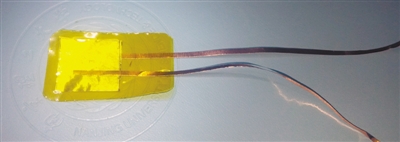A small flexible sensor helps you monitor the "number one killer" of health in real time.

Flexible sensor material sample diagram
A flexible sensor with a thickness of 200 microns (one tenth of the normal blood vessel thickness) is made of a special force-electricity conversion biomaterial and wrapped around a blood vessel or a heart, so that the subtle changes of the whole body blood pressure of the cardiovascular system in the early, middle and late stages of thrombosis can be clearly recorded on peripheral devices such as mobile phones, and at the same time, the slight differences of the cardiovascular wall pressure caused by the alienation of tissues and cells at the initial stage of the disease can be reflected more accurately and in real time.
The reporter of Science and Technology Daily recently learned from Nanjing University of Science and Technology that Professor Feng Zhangqi’s research group has created a new method for advanced prediction and real-time follow-up of cardiovascular diseases by monitoring the changes of micro-stress outside the cardiovascular wall. At present, the research group has made phased technological breakthroughs and completed the evaluation of animal clinical medicine. Related research was recently published in American Chemical Society-Nanomaterials and Devices, a top international journal in the field of nanotechnology and nanodevices.
New Nano-materials for Efficient Biomechanical-Electrical Conversion
Cardiovascular disease is the "number one killer" threatening human health, and whether the blood vessels are unobstructed is related to the normal operation of the whole cardiovascular system. Thrombosis is a small piece formed by blood flow on the surface of the inner surface of a blood vessel where it is peeled off or repaired. In the variable fluid-dependent type, thrombus consists of insoluble fibrin, deposited platelets, accumulated white blood cells and trapped red blood cells.
Experts say that "advanced prediction" and "real-time follow-up after operation" of cardiovascular diseases are the key points for effective clinical diagnosis of such diseases, especially for patients with severe cardiovascular diseases such as vascular tumor resection, intracardiac stent, valve, vascular replacement and intravascular stent. However, the existing molecular screening and imaging techniques lack accurate specific recognition function, which makes the advanced prediction and real-time tracking of cardiovascular diseases become a worldwide technical problem in clinical diagnosis and treatment.
Feng Zhangqi’s research group has long been committed to the development of bioelectronic materials and nano-devices, trying to build a new method for advanced prediction and real-time tracking of cardiovascular diseases by monitoring the changes of micro-stress outside the cardiovascular wall.
According to Dr. Li Tong, the first author of the paper, this time they pioneered a flexible nanofiber material with high-efficiency biomechanical-electrical conversion performance. Its thickness is only 200 microns, and it can accurately sense the pressure change and then show it in the form of voltage.
The material is rich in electromechanical conversion dipoles, which can generate a voltage of 1154 volts per cubic centimeter under the action of only 1000 Pascal, and has excellent stability, sensitivity and biocompatibility.
After being implanted in the body, the cardiovascular system can be monitored in real time through the mobile phone.
Based on this, the research group designed and manufactured a flexible implantable pressure sensor. They implanted the sensor into the peripheral blood vessels and heart parts of experimental animals (adult pigs), which not only clearly recorded the subtle changes of systemic blood pressure in the cardiovascular system at the early, middle and late stages of thrombosis, but also output a more accurate pressure signal, reflecting the slight difference of cardiovascular wall pressure caused by tissue and cell alienation at the initial stage of the disease in real time.
"Normal people’s blood pressure is beating with frequency, but when some tissues or cells are alienated in blood vessels, a fluctuating signal will be generated on the detector, no matter whether it is getting bigger or smaller, it is disordered. Once we detect this disordered signal and it doesn’t match the signal stored internally, we will issue some warnings, indicating that blood vessels may have problems." Feng Zhangqi said.
In the future, the flexible sensor can be implanted in the body together with cardiovascular surgery. Through the introduction of wireless signal transmitter, medical staff can track and diagnose the pathological changes of patients’ cardiovascular system in real time at clients such as mobile phones.
Feng Zhangqi explained: "We can convert it into an electrical signal that can be output by remote sensing. In the future technology, we can transform it into a signal received by a mobile phone. After receiving the signal, the mobile phone can share this signal with the hospital, so that it can be monitored remotely in real time."
At the same time, the successful development of this ultra-sensitive flexible implantable pressure sensor also provides a new method for accurate detection of micro-stress in vivo, which has great technical promotion for clinical real-time and accurate measurement of craniocerebral pressure, renal pressure and intraocular pressure.
Reporter Zhang Wei correspondent Nan Li